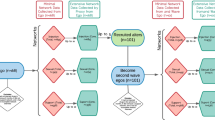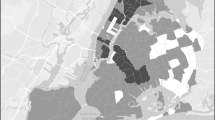Abstract
Young people in the USA who inject drugs, particularly those at a risk of residence instability, experience the highest incidence of hepatitis C (HCV) infections. This study examined associations between geographic mobility patterns and sociodemographic, behavioral, and social network characteristics of 164 young (ages 18–30) persons who inject drugs (PWID). We identified a potential bridge sub-population who reported residence in both urban and suburban areas in the past year (crossover transients) and higher-risk behaviors (receptive syringe sharing, multiple sex partners) compared to their residentially localized counterparts. Because they link suburban and urban networks, crossover transients may facilitate transmission of HIV and HCV between higher and lower prevalence areas. Interventions should address risk associated with residential instability, particularly among PWID who travel between urban and suburban areas.

Similar content being viewed by others
References
Chatterjee S, Tempalski B, Pouget ER, Cooper HL, Cleland CM, Friedman SR. Changes in the prevalence of injection drug use among adolescents and young adults in large U.S. metropolitan areas. AIDS Behav. 2011;15(7):1570–8.
Tempalski B, Pouget ER, Cleland CM, et al. Trends in the population prevalence of people who inject drugs in US metropolitan areas 1992-2007. PLoS One. 2013;8(6):e64789.
Page K, Hahn JA, Evans J, et al. Acute hepatitis C virus infection in young adult injection drug users: a prospective study of incident infection, resolution, and reinfection. J Infect Dis. 2009;200(8):1216–26.
Zibbell JE, Iqbal K, Patel RC, et al. Increases in hepatitis C virus infection related to injection drug use among persons aged </=30 years—Kentucky, Tennessee, Virginia, and West Virginia, 2006-2012. Morb Mortal Wkly Rep. 2015;64(17):453–8.
Centers for Disease Control and Prevention: Viral hepatitis surveillance. http://www.cdc.gov/hepatitis/statistics/2013surveillance/pdfs/2013hepsurveillancerpt.pdf (2013). Accessed July 20, 2016.
Centers for Disease Control and Prevention. Hepatitis C virus infection among adolescents and young adults: Massachusetts, 2002-2009. Morb Mortal Wkly Rep. 2011;60(17):537–41.
Leuchner L, Lindstrom H, Burstein GR, et al. Use of enhanced surveillance for hepatitis C virus infection to detect a cluster among young injection-drug users—New York, November 2004-April 2007 (reprinted from Morb Mortal Wkly Rep., vol 57, pg 517-521, 2008). J Am Med Assoc. 2008;300(1):34–6.
Cicero TJ, Kuehn BM. Driven by prescription drug abuse, heroin use increases among suburban and rural whites. J Am Med Assoc. 2014;312(2):118–9.
Centers for Disease C, Prevention. Notes from the field: hepatitis C virus infections among young adults--rural Wisconsin, 2010. Morb Mortal Wkly Rep. 2012;61(19):358.
Centers for Disease Control and Prevention. Use of enhanced surveillance for hepatitis C virus infection to detect a cluster among young injection-drug users, New York, November 2004-April 2007. Morb Mortal Wkly Rep. 2008;57(19):517–21.
Havens JR, Lofwall MR, Frost SD, Oser CB, Leukefeld CG, Crosby RA. Individual and network factors associated with prevalent hepatitis C infection among rural Appalachian injection drug users. Am J Public Health. 2013;103(1):e44–52.
Suryaprasad AG, White JZ, Xu F, et al. Emerging epidemic of hepatitis C virus infections among young nonurban persons who inject drugs in the United States, 2006-2012. Clin Infect Dis. 2014;59(10):1411–9.
Akyar E, Seneca KH, Akyar S, Schofield N, Schwartz MP, Nahass RG. Linkage to care for suburban heroin users with hepatitis C virus infection, New Jersey, USA. Emerg Infect Dis. 2016;22(5):907–9.
Heimer R, Barbour R, Palacios WR, Nichols LG, Grau LE. Associations between injection risk and community disadvantage among suburban injection drug users in southwestern Connecticut. USA AIDS Behav. 2014;18(3):452–63.
Alter MJ. Epidemiology of hepatitis C virus infection. World J Gastroenterol. 2007;13(17):2436–41.
Boodram B, Golub ET, Ouellet LJ. Socio-behavioral and geographic correlates of prevalent hepatitis C virus infection among young injection drug users in metropolitan Baltimore and Chicago. Drug Alcohol Depend. 2010;111(1–2):136–45.
Garfein RS, Swartzendruber A, Ouellet LJ, et al. Methods to recruit and retain a cohort of young-adult injection drug users for the Third Collaborative Injection Drug Users Study/Drug Users Intervention Trial (CIDUS III/DUIT). Drug Alcohol Depend. 2007;91(Suppl 1):S4–17.
Thorpe LE, Bailey SL, Huo D, Monterroso ER, Ouellet LJ. Injection-related risk behaviors in young urban and suburban injection drug users in Chicago (1997-1999). J Acquir Immune Defic Syndr. 2001;27(1):71–8.
Centers for Disease Control and Prevention. Estimated HIV incidence in the United States, 2007–2010. HIV Surveillance Supplemental Report 2012;17(No. 4). http://www.cdc.gov/hiv/topics/surveillance/resources/reports/%23supplemental. Published December 2012. Accessed August 1, 2017.
Rondinelli AJ, Ouellet LJ, Strathdee SA, et al. Young adult injection drug users in the United States continue to practice HIV risk behaviors. Drug Alcohol Depend. 2009;104(1–2):167–74.
Spiller MW, Broz D, Wejnert C, Nerlander L, Paz-Bailey G. HIV infection and HIV-associated behaviors among persons who inject drugs—20 cities, United States, 2012. Morb Mortal Wkly Rep. 2015;64(10):270–5.
Satterwhite CL, Torrone E, Meites E, et al. Sexually transmitted infections among US women and men: prevalence and incidence estimates, 2008. Sex Transm Dis. 2013;40(3):187–93.
Khan MR, Berger A, Hemberg J, O’Neill A, Dyer TP, Smyrk K. Non-injection and injection drug use and STI/HIV risk in the United States: the degree to which sexual risk behaviors versus sex with an STI-infected partner account for infection transmission among drug users. AIDS Behav. 2013;17(3):1185–94.
Roy E, Robert M, Vaillancourt E, Boivin JF, Vandermeerschen J, Martin I. Residential trajectory and HIV high-risk behaviors among Montreal street youth—a reciprocal relationship. J Urban Health. 2011;88(4):767–78.
German D, Davey MA, Latkin CA. Residential transience and HIV risk behaviors among injection drug users. AIDS Behav. 2007;11(6 Suppl):21–30.
Aidala A, Cross JE, Stall R, Harre D, Sumartojo E. Housing status and HIV risk behaviors: implications for prevention and policy. AIDS Behav. 2005;9(3):251–65.
Patrick DM, Strathdee SA, Archibald CP, et al. Determinants of HIV seroconversion in injection drug users during a period of rising prevalence in Vancouver. Int J STD AIDS. 1997;8(7):437–45.
Smereck GA, Hockman EM. Prevalence of HIV infection and HIV risk behaviors associated with living place: on-the-street homeless drug users as a special target population for public health intervention. Am J Drug Alcohol Abuse. 1998;24(2):299–319.
Boodram B, Mackesy-Amiti ME, Latkin C. The role of social networks and geography on risky injection behaviors of young persons who inject drugs. Drug Alcohol Depend. 2015;154:229–35.
Hotton A, Boodram B. Gender, transience, network partnerships and risky sexual practices among young persons who inject drugs. AIDS Behav. 2017;21(4):982–93.
Wiebel WW, Jimenez A, Johnson W, et al. Risk behavior and HIV seroincidence among out-of-treatment injection drug users: a four-year prospective study. J Acquir Immune Defic Syndr. 1996;12(3):282–9.
Thorpe LE, Ouellet LJ, Levy JR, Williams IT, Monterroso ER. Hepatitis C virus infection: prevalence, risk factors, and prevention opportunities among young injection drug users in Chicago, 1997-1999. J Infect Dis. 2000;182(6):1588–94.
Thorpe LE, Bailey SL, Huo D, Monterroso ER, Ouellet LJ. Injection-related risk behaviors in young urban and suburban injection drug users in Chicago, 1997-1999. J Acquir Immune Defic Syndr. 2001;27(1):71–8.
Ouellet L, Huo D, Bailey SL. HIV risk practices among needle exchange users and nonusers in Chicago. J Acquir Immune Defic Syndr. 2004;37(1):1187–96.
Huo D, Bailey SL, Hershow RC, Ouellet L. Drug use and HIV risk practices of secondary and primary needle exchange users. AIDS Educ Prev. 2005;17(2):170–84.
Project Know. Arrests across America: the current drug landscape. http://www.projectknow.com/discover/drug-arrest-across-america/#chi. Accessed July 30, 2016.
Mackesy-Amiti ME, Donenberg GR, Ouellet LJ. Prevalence of psychiatric disorders among young injection drug users. Drug Alcohol Depend. 2012;124(1–2):70–8.
Chicago Department of Public Health. HIV/STI Surveillance Report 2016. Chicago, IL: City of Chicago, December 2016. https://www.cityofchicago.org/content/dam/city/depts/cdph/HIV_STI/World_AIDS_Day_Report_012717.pdf. Accessed August 1, 2017.
Cook County Department of Public Health. HIV/AIDS Surveillance Report, 2006–2008. Oak Park, IL; 2010. www.cookcountypublichealth.org/files/pdf/HIVAIDS2006to2008Final.pdf. Accessed August 1, 2017.
Ennett ST, Bailey SL, Federman EB. Social network characteristics associated with risky behaviors among runaway and homeless youth. J Health Soc Behav. 1999;40(1):63–78.
Latkin CA, Mandell W, Knowlton AR, Vlahov D, Hawkins W. Personal network correlates and predictors of homelessness for injection drug users in Baltimore, Maryland. J Soc Distress Homel. 1998;7(4):263–78.
Metraux S, Metzger DS, Culhane DP. Homelessness and HIV risk behaviors among injection drug users. J Urban Health. 2004;81(4):618–29.
Stein JA, Nyamathi A. Correlates of hepatitis C virus infection in homeless men: a latent variable approach. Drug Alcohol Depend. 2004;75(1):89–95.
Corneil TA, Kuyper LM, Shoveller J, et al. Unstable housing, associated risk behaviour, and increased risk for HIV infection among injection drug users. Health Place. 2006;12(1):79–85.
Weir BW, Bard RS, O’Brien K, Casciato CJ, Stark MJ. Uncovering patterns of HIV risk through multiple housing measures. AIDS Behav. 2007;11(6 Suppl):31–44.
Aral SO. Behavioral aspects of sexually transmitted diseases: core groups and bridge populations. Sex Transm Dis. 2000;27(6):327–8.
Youm Y, Mackesy-Amiti ME, Williams CT, Ouellet LJ. Identifying hidden sexual bridging communities in Chicago. J Urban Health. 2009;86(Suppl 1):107–20.
U.S. Department of Health and Human Services: Action plan for the prevention, care, & treatment of viral hepatitis. http://www.cdc.gov/hepatitis/HHS-ActionPlan.htm (2014). Accessed December 15, 2016.
Buckley GJ, Strom BL. Eliminating the public health problem of hepatitis B and C in the United States: phase one report. Washington, D.C.: National Academy of Sciences; 2016.
Sulkowski MS, Gardiner DF, Rodriguez-Torres M, et al. Daclatasvir plus sofosbuvir for previously treated or untreated chronic HCV infection. N Engl J Med. 2014;370(3):211–21.
Sadler MD, Lee SS. Revolution in hepatitis C antiviral therapy. Br Med Bull.. 2015;113(1):31–44.
Dahari H, Cotler SJ, Feld JJ. Cure prevents more than transmission of HCV. Hepatology. 2016;64(3):1003–4.
van der Meer AJ, Veldt BJ, Feld JJ, et al. Association between sustained virological response and all-cause mortality among patients with chronic hepatitis C and advanced hepatic fibrosis. J Am Med Assoc. 2012;308(24):2584–93.
Barua S, Greenwald R, Grebely J, Dore GJ, Swan T, Taylor LE. Restrictions for Medicaid reimbursement of Sofosbuvir for the treatment of hepatitis C virus infection in the United States. Ann Intern Med. 2015;163(3):215–23.
Grebely J, Genoway KA, Raffa JD, et al. Barriers associated with the treatment of hepatitis C virus infection among illicit drug users. Drug Alcohol Depend. 2008;93(1–2):141–7.
Rhodes T, Treloar C. The social production of hepatitis C risk among injecting drug users: a qualitative synthesis. Addiction. 2008;103(10):1593–603.
Zeremski M, Zibbell JE, Martinez AD, Kritz S, Smith BD, Talal AH. Hepatitis C virus control among persons who inject drugs requires overcoming barriers to care. World J Gastroenterol. 2013;19(44):7846–51.
Sethi N, Tapper EB, Vong A, Sethi S, Rourke M, Afdhal NH. Direct costs of first-generation protease inhibitors for the treatment of genotype 1 chronic hepatitis C viral infection. J Viral Hepat. 2015;22(12):974–6.
Martin NK, Vickerman P, Grebely J, et al. Hepatitis C virus treatment for prevention among people who inject drugs: Modeling treatment scale-up in the age of direct-acting antivirals. Hepatology. 2013;58(5):1598–609.
Mehta SH, Genberg BL, Astemborski J, et al. Limited uptake of hepatitis C treatment among injection drug users. J Community Health. 2008;33(3):126–33.
Gutfraind A, Boodram B, Prachand N, Hailegiorgis A, Dahari H, Major ME. Agent-based model forecasts aging of the population of people who inject drugs in metropolitan Chicago and changing prevalence of hepatitis C infections. PLoS One. 2015;10(9):e0137993.
Echevarria D, Gutfraind A, Boodram B, et al. Mathematical modeling of hepatitis C prevalence reduction with antiviral treatment scale-up in persons who inject drugs in metropolitan Chicago. PLoS One. 2015;10(8):e0135901.
Marsden PV. The reliability of network density and composition measures. Soc Networks. 1993;15(4):399–421.
Author information
Authors and Affiliations
Corresponding author
Ethics declarations
The study was approved by the Institutional Review Board of the University of Illinois at Chicago.
Funding Source
This study was funded by a pilot grant award from the Chicago Developmental Center for AIDS Research (Grant#5P30AI082151–04). Other funding to support work on this manuscript include an NIH grant (R01-AI078881) and internal funding from Loyola University Chicago. The funding sources were not directly involved in the collection, analysis, or interpretation of the data; in the writing of this report; or in the decision to submit the paper for publication.
Additional information
Anna L. Hotton and Louis Shekhtman are equal contributors
Rights and permissions
About this article
Cite this article
Boodram, B., Hotton, A.L., Shekhtman, L. et al. High-Risk Geographic Mobility Patterns among Young Urban and Suburban Persons who Inject Drugs and their Injection Network Members. J Urban Health 95, 71–82 (2018). https://doi.org/10.1007/s11524-017-0185-7
Published:
Issue Date:
DOI: https://doi.org/10.1007/s11524-017-0185-7




